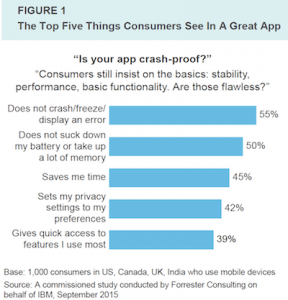 Yoram Mizrachi is founder/chief technology officer of Perfecto Mobile
Yoram Mizrachi is founder/chief technology officer of Perfecto Mobile
By Yoram Mizrachi With mobile technology becoming embedded in almost every aspect of our lives, the industry is beginning to mature. Over the past five or so years, the focus of developers and QA teams has evolved from building and launching applications to attracting a user base and to now retaining and engaging the most valuable users. Significant investment has been made to capture loyal users. The average cost to land a user who has opened an app three or more times doubled to $3 from March 2014 to March 2015, according to Fiksu. While these costs are high, so is the payoff, and it is imperative that developers maintain flawless user experiences to engage and retain users. Still, the process of capturing a loyal user has its pitfalls. On review First, a potential customer must discover a particular app among the millions and download it. When opened, it is crucial that the app work well or the brand will lose most of its audience. However, mobile users do not have a lot of patience. Only 16 percent of mobile users would try an app more than twice after failing the first and second time, according to a Forrester Research survey. The Forrester study reports that half of users' state they would uninstall an app that they classify as poor and would be less willing to interact with the company's Web site or on social media. In addition, there is always the chance that the user writes a bad review. Not only do bad reviews reduce search rankings, but also 60 percent of users think reviews are important in deciding whether or not to download an app. While users are certainly finicky, they are becoming more focused, spending more time in fewer apps. This trend is driving developers to create stronger retention strategies such as rapid updates and refinements of apps and user interfaces to keep them fresh. On average, Android apps are updated every 28 days and iOS apps every 59 days, according to research from the University of East Anglia and Center for Competition Policy. As mobile captures a higher percentage of the global digital economy, consistent engagement with mobile users is now a requirement. Some numbers to consider: • United States mobile commerce is currently 35 percent of ecommerce, according to Forrester, and is expected to reach 45 percent by 2018 – this translates to $138 billion • Global mobile payments are expected to grow 216 percent in 2016 to $27.5 billion, according to eMarketer • In 2016, also according to eMarketer, half of all digital ad spending is expected to be on mobile devices, equating to more than $100 billion • Loyal users not only consume advertising and make transactions, but also influence sales across channels. Forrester estimates that mobile influenced $1 trillion in 2015 spending at brick-and-mortar retailers • Engaging apps are also making a huge impact on the productivity of mobile workers. This trend will continue and IDC predicts that by 2020, 72.3 percent of the U.S. workforce will be mobile To capitalize on these growing opportunities, an app must deliver a high quality user experience. But what exactly makes a mobile user interface good or great? Good to great Forrester recently conducted a survey of 1,000 mobile app users to better understand the characteristics of good and great mobile apps. The two most important features are user interfaces that do not freeze and do not suck battery life and memory.
 Top 5 things consumers see in a great app. Source: Forrester Consulting for IBM
Top 5 things consumers see in a great app. Source: Forrester Consulting for IBM
